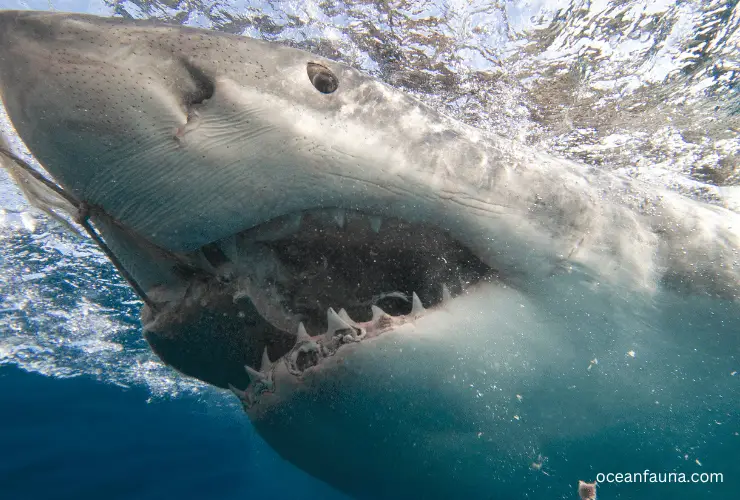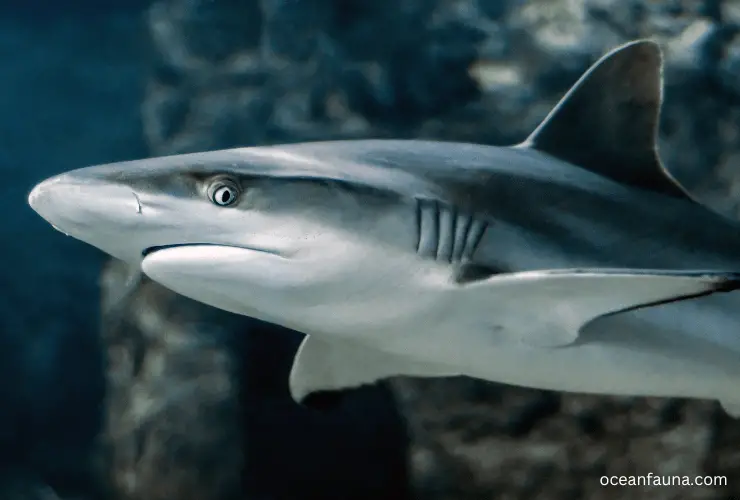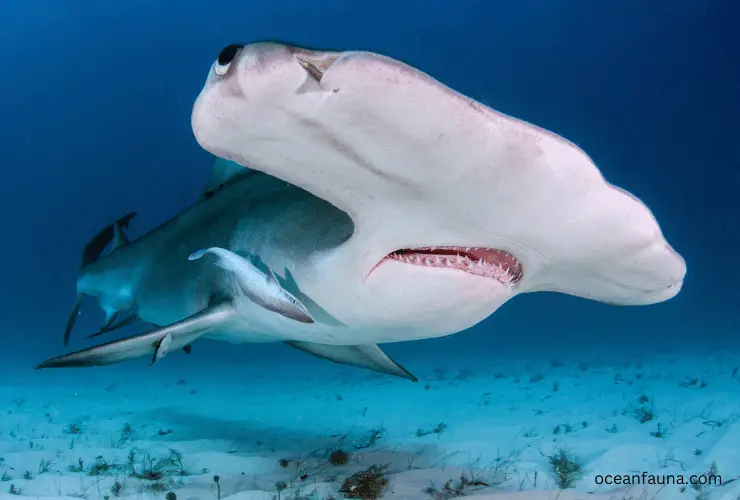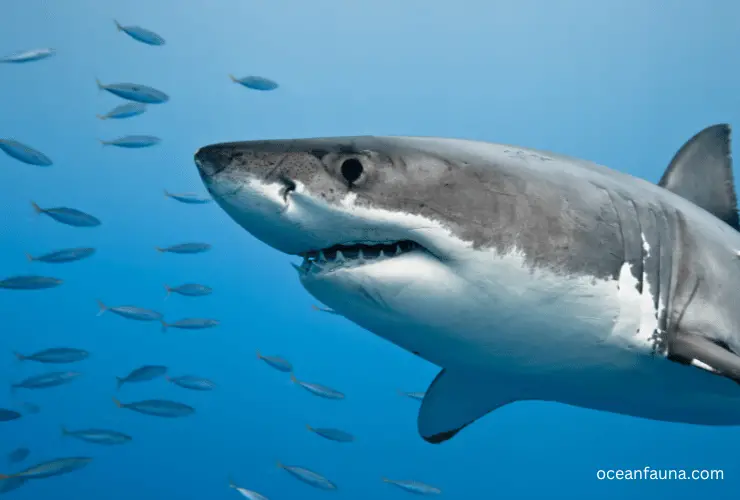No, sharks are not blind. But some sharks are color-blind, which means they can only see in shades of gray. However, with this eyesight, they can detect light, movement, and the shapes of objects.
In this article, I will discuss more details about the eyesight of sharks, which can vary depending on the species.
Can Sharks See?
Yes, sharks can see, but their vision is limited in comparison to humans. Most species of sharks are color blind, meaning they cannot perceive colors. However, this does not mean that sharks cannot recognize objects based on visual clues.
Sharks use their vision to detect movement, patterns, and light and dark contrasts. Sharks’ eyes work differently than ours due to their adaptation to living underwater. Their eyes contain more rods than cones, allowing them to see better in low-light conditions and also helps them distinguish between light and dark areas – an important skill for predation.

Additionally, some species of shark have an extra set of eyelids called nictitating membranes that help protect their eyes when attacking prey or defending themselves against predators.
In the case of vision, hammerhead sharks have 360 vision due to the shape of their head. This allows them to see in almost all directions at once, making it much easier to detect prey and predators.
All these adaptations give sharks a unique ability to detect movement, even in murky waters where visibility might be limited for other animals.
Anatomy of Sharks Eye
The anatomy of a shark’s eye consists of several important components, including the cornea, lens, iris, and retina.
- The cornea is the transparent layer at the front of the eye, focusing light onto the retina.
- The lens is a flexible structure that helps to further focus light on the retina.
- The iris regulates light entering the eye and can adjust its size depending on light conditions.
- Finally, the retina contains specialized cells called photoreceptors, which convert incoming light into an electrical signal. This signal is then sent to the brain, where it is interpreted as vision.
The most important feature of a shark’s eye is its tapetum lucidum – this highly reflective layer helps sharks see in low-light conditions. It functions as a sort of mirror that reflects any light that passes through it back onto the retina.
Also Read: Do Sharks Drink Water? Role of Sea Water in Sharks’ Lives
This means that even faint amounts of available light can be amplified significantly before reaching photoreceptor cells in the retina, enabling sharks to effectively hunt for prey in murky or deep waters where conventional sight would not be possible.
In addition to their ability to see in low-light conditions, sharks are also believed to have some degree of polarization sensitivity – meaning they can detect subtle changes in the angle at which sunlight enters their eyes, allowing them a unique ability to locate prey with greater accuracy than many other predators.
Can Sharks See in The Dark?
Yes, sharks can see in the dark. Sharks have a layer of mirrored crystals behind their retina called tapetum lucidum that reflects light, giving them a second chance to see the image as it goes through the retina again. This enables them to detect their prey even in low-light conditions or murky water where other predators would be unable to see anything.

Additionally, they also have an array of specialized cells called photoreceptors, which allow them to distinguish various shades and intensities of light. This means that they can make out objects like fish in the darkness and determine if it is safe for them to attack.
Also See: Are Sharks Tetrapods? [Answered]
In addition to this, sharks also possess special organs known as lateral lines that detect vibrations in the water and help locate moving prey in times of darkness or poor visibility.
These remarkable adaptations, paired with their incredibly sharp senses of smell and hearing, enable sharks to effectively hunt in even the darkest sea depths- a feat that other predators cannot quite accomplish.
Can Sharks See the Red Color of Blood?
No, sharks cannot see the red color of blood because they are color blind. Sharks do not have the same eyesight as humans and can only distinguish between light and dark. Instead of being able to distinguish between different colors, sharks rely on their sense of smell and vibrations in the water to detect prey or other sources of blood in the ocean.
Sharks can smell blood from up to half a mile away due to their highly sensitive olfactory receptors that can pick up on even trace amounts of various substances dissolved in seawater.
Additionally, their lateral lines (a system of sensory organs located along each side of the body) can detect minute changes in pressure around them, allowing them to sense their prey’s movements in the water based on vibrations produced by swimming or struggling.
Can Sharks See Humans?
Yes, sharks can see humans. Although they cannot distinguish color as humans do, they have developed a vision that allows them to recognize shapes and silhouettes.
Sharks use their acute sense of sight to help them identify objects in the water or spot prey from a distance, so they can notice humans in their vicinity.
But, in the case of great white sharks, they can hardly detect humans. That is why these sharks accidentally attack humans, considered as prey.
Can Sharks See When They Attack?
Sharks can see when they attack, but the vision is short-range and limited. Sharks have small eyes relative to their large size, so their vision is not as sharp or wide-reaching as other animals.

Additionally, because they rely on motion to detect prey, they are essentially blind during the last moments of an attack. They can only see their target for about 1.5 seconds before striking.
A shark has eyelids that close like ours to protect and cleanse its eyes from debris. This helps keep its eyes free from damage and blocks out any light that could be distracting while hunting in murky waters.
Do Sharks Have Eyelids?
Yes, sharks do have eyelids. Sharks have two eyelids like human beings, which are known as the upper and lower eyelids. The lower eyelid helps protect the eye from dust and other foreign objects, while the upper eyelid assists in keeping water out of the eyes.
Also Read: Are There Sharks in Italy? Yes!
In addition to these two eyelids, sharks also possess a third eyelid called the nictitating membrane. This membrane is a thin, clear protective layer located at the corner of each eye that helps keep debris away from their eyes and provides additional protection when hunting or swimming in rough waters. It can be retracted or fully opened depending on the activity that they are engaging in.
Another important function of this third eyelid is to help hydrate and lubricate their eyes so they can see underwater.
Do Sharks Blink?
No, sharks do not blink as humans do. As I mentioned above, unlike us, sharks have a nictitating membrane, also known as a third eyelid, which is a protective barrier between the cornea and the eye. This membrane moves horizontally across the eye to keep it lubricated and clean of any debris.
Sharks use this mechanism to protect their eyes from any potential harm or damage caused by things such as food particles or the environment they are swimming in.
The nictitating membrane works differently than a human blink because it covers all of the eye surfaces instead of just the top and bottom lids coming together.
When something has caused damage to their eye, some species of shark can even coat their entire eyeballs with this membrane to further protect them while healing occurs.
Do Sharks Ever Close Their Eyes?
No, sharks do not close their eyes. Instead, they are able to enter a state of rest called “tonic immobility,” during which they remain alert but become less responsive to external stimuli while their body metabolism decreases and their breathing slows.

This state is believed to be a form of protection against predators or other threats that may be in the vicinity. Sharks may also engage in this type of resting behavior when they experience stress or hunger.
During this time, their eyes remain open, and they continue to monitor the movements of any creatures around them, even though they appear to be sleeping.
Is There a Shark That Is Blind?
Believe it or not, a shark with no vision exists: the Brachaelurus Waddi. Commonly known as the Blind Shark and belonging to the family Brachaeluridae, this species stands alongside its relative-the Bluegrey Carpetshark-as one of two carpet sharks in existence.
Blind Sharks are small sharks ranging from 60–90 cm in length and can be found around Australia and New Zealand. Their unique adaptation helps them survive in their deep-sea environment: they possess no eyes or eye sockets at all. This lack of vision gives them an advantage when hunting for prey in the darkness of the ocean depths.
To compensate for their lack of sight, Blind Sharks rely on their keen sense of smell and lateral line system to locate food sources and navigate their way through murky waters. These adaptations make them one of the few species of shark able to hunt and thrive without relying on vision alone.
FAQs
Are great white sharks blind?
Great white sharks are color-blind instead of completely blind. They are able to distinguish between light and dark, but not different colors, so they rely mostly on their sense of smell and hearing to locate food sources.
Are there any sharks with color vision?
No, there are no sharks with color vision. Sharks lack the photoreceptors and optics necessary to perceive colors. Instead, they rely on other means of navigation and locating prey, such as electroreception (sensing electric fields) and sensing vibrations in the water.
A recent study by Australian scientists determined that none of the nearly 500 species of sharks possess color vision, despite the fact their close relatives – rays, and chimeras – can recognize some colors.
This may be due to an evolutionary adaptation within sharks that allows them to survive in dimly lit environments such as deep ocean trenches. It is possible that this adaptation came at the expense of sacrificing color vision for other more important survival mechanisms.
Conclusion
So, it is confirmed that no sharks are blind except Brachaelurus Waddi (Blind Shark). All other sharks can see, but they can’t detect the color. So, all they do is rely on the movement of objects, sense of smell, and detection of electric fields.
They also have a defense mechanism called tonic immobility, which helps them remain alert while resting. This information can be used by biologists and marine scientists to protect these animals from threats as well as to study their behavior more closely.

